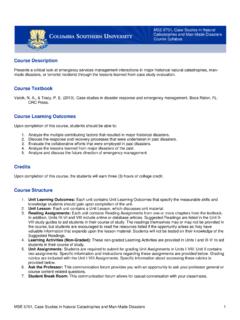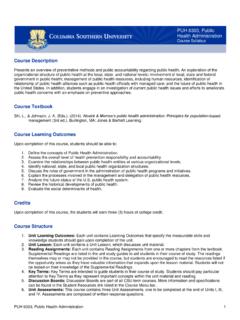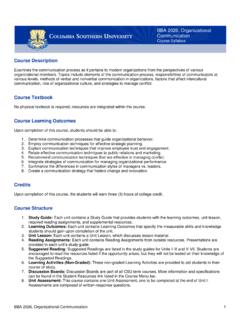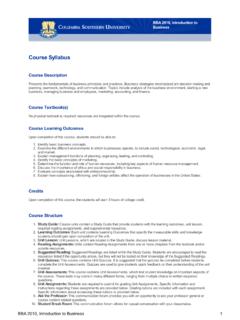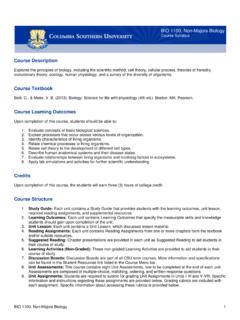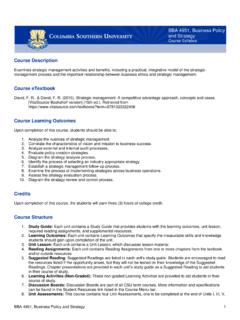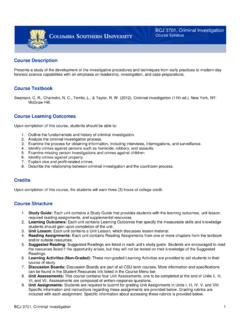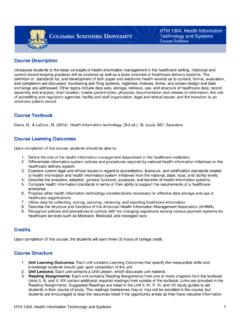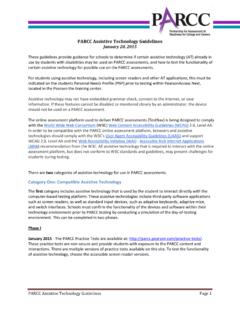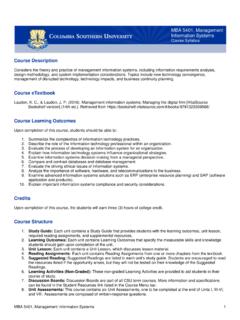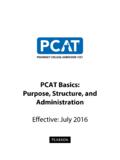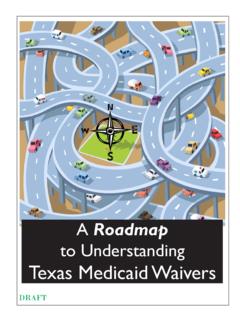Transcription of FIR 4314, Crime Scene, Forensics, and Evidence …
1 FIR 4314, Crime scene , Forensics, and Evidence collection 1 Course Description Explores the analytical and systematic approach relating to fire scene investigations involving Crime scenes, accidental causes, and the collection of Evidence . The role of evolving technologies used for fire scene investigations is studied with emphasis on the use of forensic science in reconstructing an incident. The modern fire investigator must be able to justify the validity and reliability of his or her findings against peer review. This course prepares students for contemporary methods of fire investigations. Course Textbook Icove, D. J., De Haan, J. D., & Haynes, G. A. (2013). forensic fire scene reconstruction (3rd ed.). Upper Saddle River, NJ: Pearson. Course Learning Outcomes Upon completion of this course, students should be able to: 1. Explain the fundamentals of forensic science as used in fire investigations.
2 2. Define the scientific method used to complete a fire investigation. 3. Explain the use of fire dynamics in a fire investigation. 4. Classify fire patterns and their causes. 5. Illustrate the proper documentation and reconstruction of a fire scene . 6. Outline the development of a working hypothesis of a fire investigation. 7. Interpret the factors that contribute to human injuries and deaths involving fire. 8. Describe the different types of fire testing and the use of fire test data. Credits Upon completion of this course, the students will earn three (3) hours of college credit. Course Structure 1. Unit Learning Outcomes: Each unit contains Learning Outcomes that specify the measurable skills and knowledge students should gain upon completion of the unit. 2. Unit Lessons: Each unit contains a Unit Lesson, which discusses unit material. 3. Reading Assignments: Each unit contains Reading Assignments from one or more chapters from the textbook or other resources.
3 Suggested Readings are listed in the unit study guides to aid students in their course of study. The readings themselves may or may not be provided in the course, but students are encouraged to read the resources listed if the opportunity arises as they have valuable information that expands upon the lesson material. Students will not be tested on their knowledge of the Suggested Readings. Chapter presentations are provided in each unit study guide as Suggested Reading to aid students in their course of study. 4. Discussion Boards: Discussion Boards are part of all CSU term courses. More information and specifications can be found in the Student Resources link listed in the Course Menu bar. 5. Unit Assessments: This course contains five Unit Assessments, one to be completed at the end of Units I, II, V, VII, and VIII. Assessments are composed of written response questions.
4 6. Unit Assignments: Students are required to submit for grading Unit Assignments in Units II, III, IV, VI, and VII. Specific information and instructions regarding these assignments are provided below. Grading rubrics are included with each assignment. Specific information about accessing these rubrics is provided below. FIR 4314, Crime scene , Forensics, and Evidence collection Course Syllabus FIR 4314, Crime scene , Forensics, and Evidence collection 2 7. Ask the Professor: This communication forum provides you with an opportunity to ask your professor general or course content related questions. 8. Student Break Room: This communication forum allows for casual conversation with your classmates. CSU Online Library The CSU Online Library is available to support your courses and programs. The online library includes databases, journals, e-books, and research guides.
5 These resources are always accessible and can be reached through the library webpage. To access the library, log into the myCSU Student Portal, and click on CSU Online Library. You can also access the CSU Online Library from the My Library button on the course menu for each course in Blackboard. The CSU Online Library offers several reference services. E-mail and telephone ( ) assistance is available Monday Thursday from 8 am to 5 pm and Friday from 8 am to 3 pm. The library s chat reference service, Ask a Librarian, is available 24/7; look for the chat box on the online library page. Librarians can help you develop your research plan or assist you in finding relevant, appropriate, and timely information. Reference requests can include customized keyword search strategies, links to articles, database help, and other services. Unit Assignments Unit II Essay For this assignment, please complete the following: Explain the fundamentals of forensic science as used in fire investigations.
6 Define and explain the scientific method, along with the seven basic steps utilized in the systematic approach. Your response should be a minimum of 700 words in length. You are required to use at least your textbook as source material for your response. All sources used, including the textbook, must be referenced; paraphrased and quoted material must have accompanying citations. All references and citations used must be in APA style. Information about accessing the Blackboard Grading Rubric for this assignment is provided below. Unit III Essay In this writing project, you will explain and reflect on various fire dynamics and fire-pattern concepts. Include the following in this assignment: Discuss the use of fire patterns in an investigation. Correlate how recognizing fire patterns relates to fire dynamics. Describe how plume calculations assist in explaining fire patterns.
7 Your response should be a minimum of 700 words in length. You are required to use at least your textbook as source material for your response. All sources used, including the textbook, must be referenced; paraphrased and quoted material must have accompanying citations. All references and citations used must be in APA style. Information about accessing the Blackboard Grading Rubric for this assignment is provided below. Unit IV Essay Read the following article: Burnette, G. E. ( ). Spoliation of Evidence : A fire scene dilemma. Retrieved from Additionally, use the Internet and the CSU Online Library to search for articles and case citations (such as those found on page 218, Table 4-4) related to NFPA 921 and ASTM E860 on spoliation. Respond to the following questions, and reference at least one article from the CSU Online Library in your response: FIR 4314, Crime scene , Forensics, and Evidence collection 3 1.
8 Define spoliation. 2. Compare and contrast when Evidence should be secured in place and when it should be removed from the scene . 3. Discuss how to document the area prior to removing a piece of Evidence . 4. What specific guidelines would you recommend implementing in order to improve the effectiveness of scene documentation? Your response should be a minimum of two pages in length. You are required to use at least your textbook and one article from the CSU Online Library as source materials for your response. All sources used, including the textbook, must be referenced; paraphrased and quoted material must have accompanying citations. All references and citations used must be in APA style. Information about accessing the Blackboard Grading Rubric for this assignment is provided below. Unit VI Case Study For this assignment, locate and read the following case study: Madrzykowski, D.
9 , Forney, G. P., & Walton, W. D. (2002). Simulation of the dynamics of a fire in a two-story duplex Iowa, December 22, 1999. Retrieved from Once you have read and reviewed the case scenario, respond to the following questions with thorough explanations and well-supported rationale: 1. What fire model did they use for analysis, and was the model they chose verified and validated? Explain. 2. What other programs were used for their study, and why did they use them? 3. What types of data were used for the simulation? 4. Was their approach to the fire model probabilistic or deterministic, and explain why? 5. Did their simulation findings match the actual conditions? Your critique should be a minimum of two pages, double-spaced, excluding the title and reference pages. All sources used, including the textbook, must be referenced; paraphrased and quoted material must have accompanying citations.
10 All references and citations used must be in APA style. Information about accessing the Blackboard Grading Rubric for this assignment is provided below. Unit VII Article Critique Locate the following article in the Academic Search Complete database in the CSU Online Library: Barowy, A., & Madrzykowski, D. (2012). Analysis of a fatal wind-driven fire in a single-story house. Fire Engineering, 165(6), 63-76. Read the article and write a critique that includes the following elements: a brief introduction to the article; summary of the key points in the article; discussion of how the article supports the use of such things as fire-dynamics simulators, fire- scene drawings, photography, and timelines in the reconstruction of the fire scene ; and summary of the article's conclusions and your own opinions. Your critique should be a minimum of two pages, double-spaced, excluding the title and reference pages.
